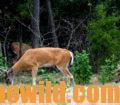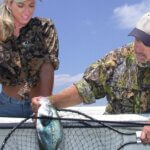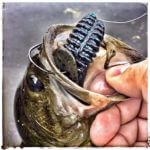Editor’s Note: Each state has different plant times when you’re planting for wildlife. The two best resources for knowing when to plant will be the companies you buy your seeds from and your state Department of Conservation. You can attract deer to an area, if you know what causes deer to come to certain foods at specific times of the year. You can find the magic ingredient that can put bucks where you want them during deer season right under your fingertips. Yet most hunters don’t know how, when or where to use fertilizer, which consistently will pay buck dividends each season. “I’ve seen deer walk through a green field to feed on fertilized plants and pass-by those plants not fertilized,” says Dr. Keith Causey, a retired professor of wildlife science at Auburn University and once head of the deer-research program there. “Deer seem to select the most-nutritious food they can find to eat. Therefore deer will come to and feed on fertilized plants more readily than on plants not fertilized.” You can fertilize green fields, nut and fruit trees and naturally-occurring wild plants to put bucks where you want them during hunting season. You also can plant seeds for wildlife food and put out mineral blocks.
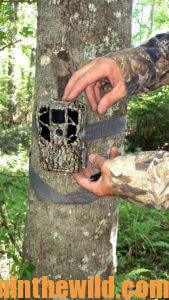 In June, 2021, I started my wildlife management program for Alabama’s deer season that would begin in mid-October by putting out Mossy Oak’s BioLogic BioRock (https://www.plantbiologic.com), a mineral lick that attracts deer. I put a trail camera to photograph the deer using the BioRock. Four weeks later at the end of June, my son and I put out two deer attractants from Southern Buck Wildlife products: Antler Magnet Wildlife Feed that’s 13% protein and contains corn, peanuts, roasted soybeans and peanut flavoring; and Rackmaker Wildlife Feed that’s 16% protein and contains corn, soybeans and molasses as well as calcium, and Vitamin A, D3 and minerals – from Southeastern Seed & Feed (https://southernseedfeed.com/). Even with a deviated septum (broken nose) I could smell the strong aromas of theses attractants as soon as we opened the bags. There was no question that these attractants would draw deer. We checked the weather forecast before we put these feed attractants on the ground to make sure our area wasn’t due to have any rain events. We hoped to get a deer-herd census from trail camera photos and learn if any of our bucks had started growing antlers.
In June, 2021, I started my wildlife management program for Alabama’s deer season that would begin in mid-October by putting out Mossy Oak’s BioLogic BioRock (https://www.plantbiologic.com), a mineral lick that attracts deer. I put a trail camera to photograph the deer using the BioRock. Four weeks later at the end of June, my son and I put out two deer attractants from Southern Buck Wildlife products: Antler Magnet Wildlife Feed that’s 13% protein and contains corn, peanuts, roasted soybeans and peanut flavoring; and Rackmaker Wildlife Feed that’s 16% protein and contains corn, soybeans and molasses as well as calcium, and Vitamin A, D3 and minerals – from Southeastern Seed & Feed (https://southernseedfeed.com/). Even with a deviated septum (broken nose) I could smell the strong aromas of theses attractants as soon as we opened the bags. There was no question that these attractants would draw deer. We checked the weather forecast before we put these feed attractants on the ground to make sure our area wasn’t due to have any rain events. We hoped to get a deer-herd census from trail camera photos and learn if any of our bucks had started growing antlers.
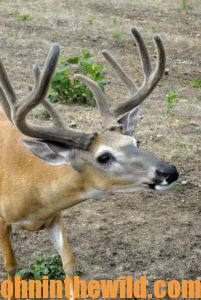 For a buck to grow to his maximum potential, he must have a quality year-round food supply with plenty of protein. Good soils with limited hunting pressure and a deer herd that doesn’t surpass the carrying capacity of the land may produce this quality food naturally. However, on hunting lands without these ideal conditions, you still can produce an abundance of food by using fertilizer and quality seeds to help the deer grow heavier body weights and bigger antlers. Then by knowing how, when and where to grow this food, you can wait at the deer’s dinner table when the buck comes to eat and harvest him once he reaches the size you want to take.
For a buck to grow to his maximum potential, he must have a quality year-round food supply with plenty of protein. Good soils with limited hunting pressure and a deer herd that doesn’t surpass the carrying capacity of the land may produce this quality food naturally. However, on hunting lands without these ideal conditions, you still can produce an abundance of food by using fertilizer and quality seeds to help the deer grow heavier body weights and bigger antlers. Then by knowing how, when and where to grow this food, you can wait at the deer’s dinner table when the buck comes to eat and harvest him once he reaches the size you want to take.
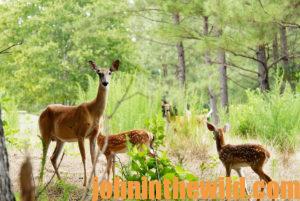 When planting a green field, choose or clear an area close to thick cover. Bucks prefer to have the protection of thick cover as they come to or leave from a green field. Next have a soil test done to tell you whether you need to lime and/or fertilize the region before you plant it. If you go to the trouble to plant and grow a green field, you want the plot to produce as much high-quality and nutritious food as possible for the deer. Most hunters know that late winter usually means a stressful time for deer due to a lack of accessible naturally-occurring food. Therefore green fields become productive places to harvest bucks during the late winter months — not only because the deer come to the green fields for the available food but also because does tend to congregate on green fields during the rut.
When planting a green field, choose or clear an area close to thick cover. Bucks prefer to have the protection of thick cover as they come to or leave from a green field. Next have a soil test done to tell you whether you need to lime and/or fertilize the region before you plant it. If you go to the trouble to plant and grow a green field, you want the plot to produce as much high-quality and nutritious food as possible for the deer. Most hunters know that late winter usually means a stressful time for deer due to a lack of accessible naturally-occurring food. Therefore green fields become productive places to harvest bucks during the late winter months — not only because the deer come to the green fields for the available food but also because does tend to congregate on green fields during the rut.
 For the food plot to produce the most-nutritious food over a long time, it needs regular doses of fertilizer, like that made by Mossy Oak BioLogic (http://www.plantbiologic.com), the Scotts Company (http://www.scotts.com) and others. But few people want to spend time fertilizing a green field when they can hunt instead. Time-released fertilizer solves that problem. By using time-released fertilizer in the late summer and early fall, the fertilizer continues to provide nutrients to the green field throughout the winter and the early spring, enabling your plants to ,produce more protein and more food for deer.
For the food plot to produce the most-nutritious food over a long time, it needs regular doses of fertilizer, like that made by Mossy Oak BioLogic (http://www.plantbiologic.com), the Scotts Company (http://www.scotts.com) and others. But few people want to spend time fertilizing a green field when they can hunt instead. Time-released fertilizer solves that problem. By using time-released fertilizer in the late summer and early fall, the fertilizer continues to provide nutrients to the green field throughout the winter and the early spring, enabling your plants to ,produce more protein and more food for deer.
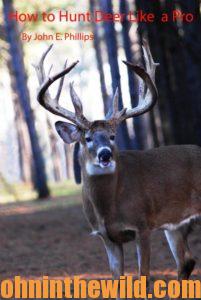 To learn more about hunting deer, check out John E. Phillips’ book, “How to Hunt Deer Like a Pro,” available in Kindle, Print and Audible versions, at (http://amzn.to/YpoQHA). You may have to copy and paste this link into your browser. (When you click on this book, notice on the left where Amazon says you can read 10% of the book for free, and you can hear 10% for free).
To learn more about hunting deer, check out John E. Phillips’ book, “How to Hunt Deer Like a Pro,” available in Kindle, Print and Audible versions, at (http://amzn.to/YpoQHA). You may have to copy and paste this link into your browser. (When you click on this book, notice on the left where Amazon says you can read 10% of the book for free, and you can hear 10% for free).


